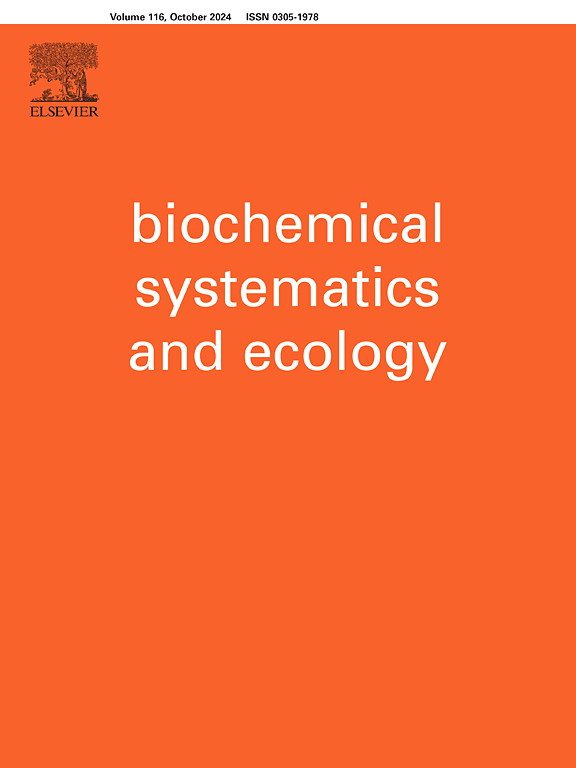Population variability of volatile secondary metabolites in Hypericum aviculariifolium subsp. depilatum var. depilatum
IF 1.4
4区 生物学
Q4 BIOCHEMISTRY & MOLECULAR BIOLOGY
引用次数: 0
Abstract
Chemical analyses of flowering tops of eleven wild populations of Hypericum aviculariifolium subsp. depilatum var. depilatum (Hypericaceae), an endemic species of Turkish flora, identified 25 to 36 volatile secondary metabolites (VSM). Oxygenated monoterpenes such as linalool, camphor and verbenol and sesquiterpenic hydrocarbons such as β-selinene, γ-cadinene and β-caryophyllene were recognized as the main ingredients across populations. This is the first report documenting the variability of volatile secondary metabolites among wild populations of this endemic species. Data acquired were also discussed in terms of their possible chemotaxonomic significance.

金丝桃挥发性次生代谢物的种群变异。脱毛怪,脱毛怪
11个金丝桃野生居群花顶化学分析。土耳其特有种脱毛草(Hypericaceae),鉴定出25 ~ 36种挥发性次生代谢物(VSM)。芳樟醇、樟脑、马尾酚等含氧单萜化合物和β-亚麻烯、γ-二烯、β-石竹烯等倍半萜化合物是各种群的主要成分。这是首次记录该特有物种野生种群中挥发性次生代谢物变异性的报告。所获得的数据也就其可能的化学分类意义进行了讨论。
本文章由计算机程序翻译,如有差异,请以英文原文为准。
求助全文
约1分钟内获得全文
求助全文
来源期刊

Biochemical Systematics and Ecology
生物-进化生物学
CiteScore
3.00
自引率
12.50%
发文量
147
审稿时长
43 days
期刊介绍:
Biochemical Systematics and Ecology is devoted to the publication of original papers and reviews, both submitted and invited, in two subject areas: I) the application of biochemistry to problems relating to systematic biology of organisms (biochemical systematics); II) the role of biochemistry in interactions between organisms or between an organism and its environment (biochemical ecology).
In the Biochemical Systematics subject area, comparative studies of the distribution of (secondary) metabolites within a wider taxon (e.g. genus or family) are welcome. Comparative studies, encompassing multiple accessions of each of the taxa within their distribution are particularly encouraged. Welcome are also studies combining classical chemosystematic studies (such as comparative HPLC-MS or GC-MS investigations) with (macro-) molecular phylogenetic studies. Studies that involve the comparative use of compounds to help differentiate among species such as adulterants or substitutes that illustrate the applied use of chemosystematics are welcome. In contrast, studies solely employing macromolecular phylogenetic techniques (gene sequences, RAPD studies etc.) will be considered out of scope. Discouraged are manuscripts that report known or new compounds from a single source taxon without addressing a systematic hypothesis. Also considered out of scope are studies using outdated and hard to reproduce macromolecular techniques such as RAPDs in combination with standard chemosystematic techniques such as GC-FID and GC-MS.
 求助内容:
求助内容: 应助结果提醒方式:
应助结果提醒方式:


